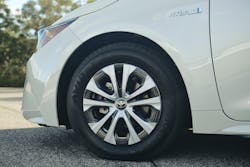The company that brought hybrid vehicles to the masses doesn’t see them as a fringe component of its business. They’re not limited to the hippies or the hipsters. They’re the future.
Toyota Motor Corp. created the world’s first mass-produced gas/electric hybrid vehicle. The Prius was introduced in late 1997 in Japan, released worldwide in 2000, and the 2001 Prius made its debut in the U.S. market in August 2000.
In 2011 Toyota Motor Sales USA sold its one millionth Prius, and by the middle of 2012 had sold another half million. And the company has extended and improved its hybrid technology to other sedans and SUVs, most recently including the world’s best-selling car, the Corolla. The Lexus line has six hybrid options of its own.
Mike Donick is the vehicle dynamics senior manager for Toyota Motor North America Inc. He says the proliferation of hybrid technology will continue throughout Toyota’s vehicle lineup. “We’re planning to grow that exponentially as we move forward. We think hybrid or electrification is growing dramatically,” says Donick. “Right now about 9% of our products are hybrid, and we expect to grow that to 15% by 2020. The target is by 203 0 it will be 50% globally.”
Here’s one more goal for one of the world’s largest automakers: to have an electrified option in every Toyota and Lexus model by 2025.
“We have more development projects for North America than we’ve ever had before, so it’s a busy time, but it’s an exciting time.”
Pushing the envelope for performance
With such an emphasis on alternative fuel vehicles for the future, Modern Tire Dealer turned to Toyota to talk about what this means for the development of original equipment tires, and ultimately, the replacement tire market.
Donick leads a team of 10 engineers that focuses on ride handling vehicle performance, including all of the tire development for Toyota in North America. Most of them work from the 12,000-acre Toyota Arizona Proving Grounds.
At any given time two of those engineers are working on tire development — so he estimates tires account for 20% of their work. And a growing amount of that tire work involves fuel efficient products. Donick says Toyota is choosing fuel efficient, low rolling resistant tires for its conventional vehicles, as well as its hybrids.The company’s tire research is broken down into two categories — tire development for new vehicle projects, and overall improvements that result in better tires. The OE work typically stretches over a couple of years with constant back-and-forth between Toyota and its tire manufacturing partners, including Michelin North America Inc. and Goodyear Tire & Rubber Co. One tire maker creating an OE fitment on a Camry “has probably tried on the order of 40 different designs to come up with the best tire design for that specific application, and that’s just from one supplier.”
Donick says, “We develop tires that are specifically matched to that vehicle; they are purpose built for our performance. We go through many iterations so that the characteristics of that tire are perfectly matched to the characteristics of the vehicle for the best ride comfort, handling, steering feel, fuel economy and rolling resistance, and braking performance.”
And while Toyota conducts tire research alongside its OE tire makers, it also works on its own. Creating better tires for the future requires a focus on the best balance of targets so the company can accurately predict performance. Donick says that necessitates a focus on three things: the tire’s construction and shape, its compounds, and the tread pattern.
With a base of repeated tests and predictable performance, the company can make educated adjustments. For instance, if it adjusts the angle of a tire belt slightly, “we know what kind of performance change we’re going to see in the vehicle.” From there, the goal is to push the envelope while “always trying to see how we can get a bigger envelope and have both better softness and better ride comfort. We’re trying to optimize the tire in both areas.”
Serving the consumer
With its ongoing push into the hybrid market, it’s logical to expect Toyota to remain dedicated to the development of better green tires. But are fuel efficiency and low rolling resistance the first priority at the outset of a new hybrid project?
“At a higher level I’d say customer satisfaction is priority one, and low rolling resistance is a big piece of it,” Donick says. “The way we set our targets and then develop the tires to meet those targets is we start at the customer level. We want the customer to have a certain level of ride comfort, fuel economy, handling performance, snow, wet performance, etc. Then we look at the vehicle and tire as a system, and we try to figure out how we can optimize the system to try to get the best overall performance for the customer.”
One of the trade-offs of a low rolling resistance tire is ride comfort, but Donick says Toyota expects its hybrid vehicles to perform for customers just as its non-hybrids do. That means a hybrid vehicle’s suspension system has to be tweaked and developed in a way to compensate for the loss of ride comfort. Once that’s complete, the auto maker will set specifications for the tire based on the vehicle’s fuel economy. There are other targets for stopping distance, handling, ride comfort and snow.
Another important priority for hybrid vehicles is tire noise. “When the engine’s not running it’s very quiet, so there’s a little additional emphasis on low road noise for hybrid tires.”
Consumer expectations, and requests, drive the complicated process of setting performance targets, and Donick says it involves four paths of information.
When updating a vehicle model, the first goal is to address any customer dissatisfaction from the previous models. That might come from customer complaints at dealerships, or from warranty problems that were reported. The second step is to look at customer satisfaction rankings, such as those reported by J.D. Power and Associates and media outlets like Consumer Reports. Toyota also conducts interviews with customers, and talks to its dealer staff about what they’re hearing from vehicle owners. The final piece is competitive benchmarking. Toyota wants to be competitive or the best in its segment.
“Trying to take what the customer wants and converting that into our performance targets is a big part of our job, and a pretty complex part of the job, but it’s a very important one.”
Bigger green tires are coming
One thing that’s set the expansion of hybrid vehicles apart from the rest of the tire industry has been tire sizing.
While the tire industry has focused on larger sized tires— 17-inch and 18-tires have become the leaders — vehicles on hybrid vehicles remain smaller. (The top passenger tire size, 225/65R17, entered the U.S. Tire Manufacturers Association’s top 10 list of most popular sizes in 2014, and ascended to the top of the list three years later.) The Toyota Prius offers an option with a 17-inch tire, P215/45R17, but since 2010 it’s been fitted with P195/65R15 tires. The 2020 Corolla hybrid will debut with the same size.
But it might not always be that way.
“I think with low rolling resistance tires, as we move forward you’ll see them penetrate the entire size market, maybe with the exception of very large section widths. We still don’t have very much in the plans for your 285 and 295 and up because that large width by nature isn’t so efficient for rolling resistance. But in diameter size, I’m confident within four years you’ll have 22s that are low rolling resistant.”
Donick says he thinks the expansion will be led by the auto makers since “we’re developing larger vehicles that are also hybrid. They need to maintain a balance of good styling, performance, wheel diameter, as well as good fuel economy performance.” ■
The rise of hybrids
The first alternative fuel and hybrid electric vehicles (AFV and HEV) models were introduced in 1991; the market leader Toyota entered the fray at the end of 1997 and the company brought the 2001 Prius to the U.S. in August 2000.
Two decades later, for model year 2018, 31 manufacturers and brands offered 203 different models, according to the U.S. Department of Energy’s Alternative Fuels Data Center. In the last 28 years, the “Big 3” auto manufacturers have introduced almost two-thirds of the alternative fuel vehicles to the marketplace.
By 2025, 18% of light vehicles produced will be a hybrid of alternative energy, according to a Specialty Equipment Market Association Future Trends report. Toyota’s Mike Donick says the automaker expects 15% of its products to be hybrid vehicles by 2020. By 2030, the goal is to make hybrids account for half of Toyota’s global vehicle production. — Joy Kopcha
About the Author
Joy Kopcha
Managing Editor
Joy Kopcha joined Modern Tire Dealer and Auto Service Professional as senior editor in 2014 after working as a newspaper reporter for a dozen years in Kansas, Indiana and Pennsylvania. She was named managing editor of MTD and ASP in 2022, and took on that same role with Motor Age in 2024.
She is an award-winning journalist, including in 2023 when she was named a Jesse H. Neal Awards Finalist.
Don't miss any of her articles. Sign up for MTD's newsletters.

